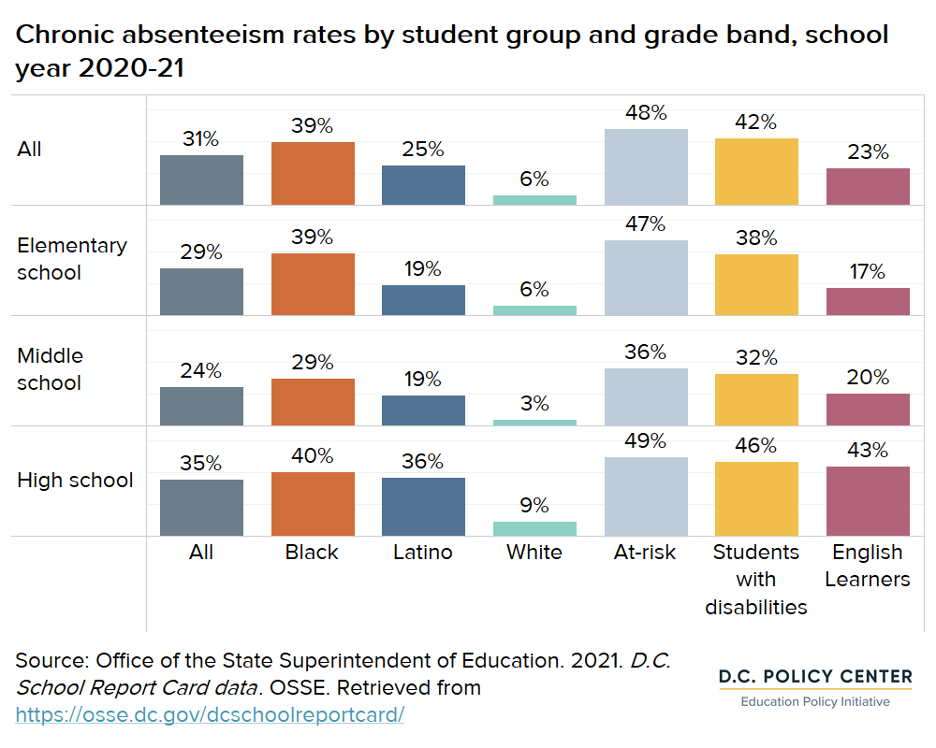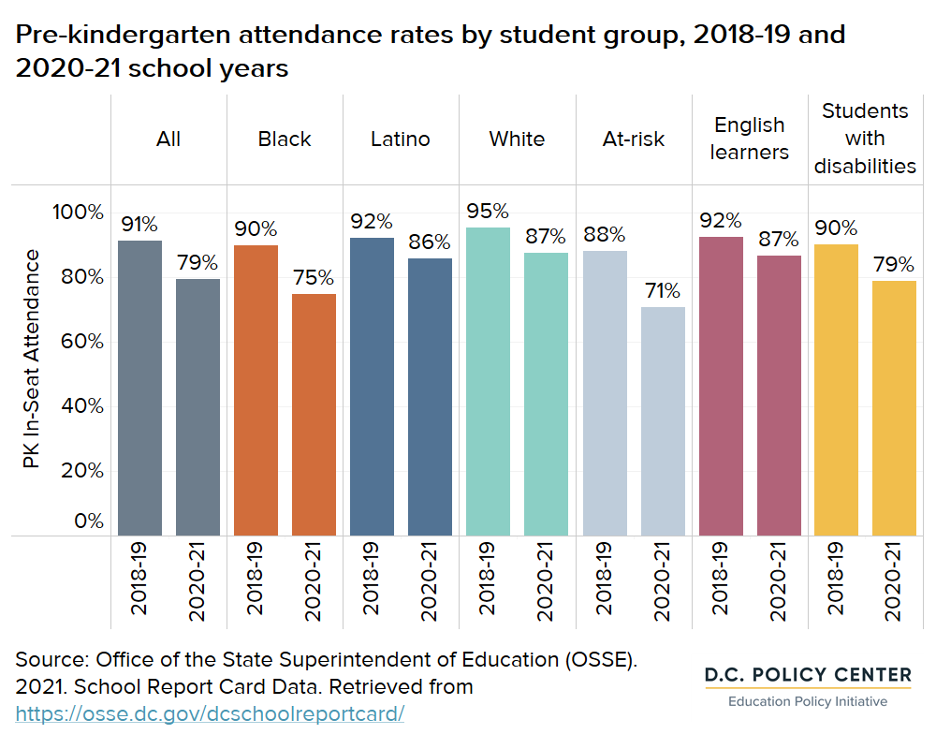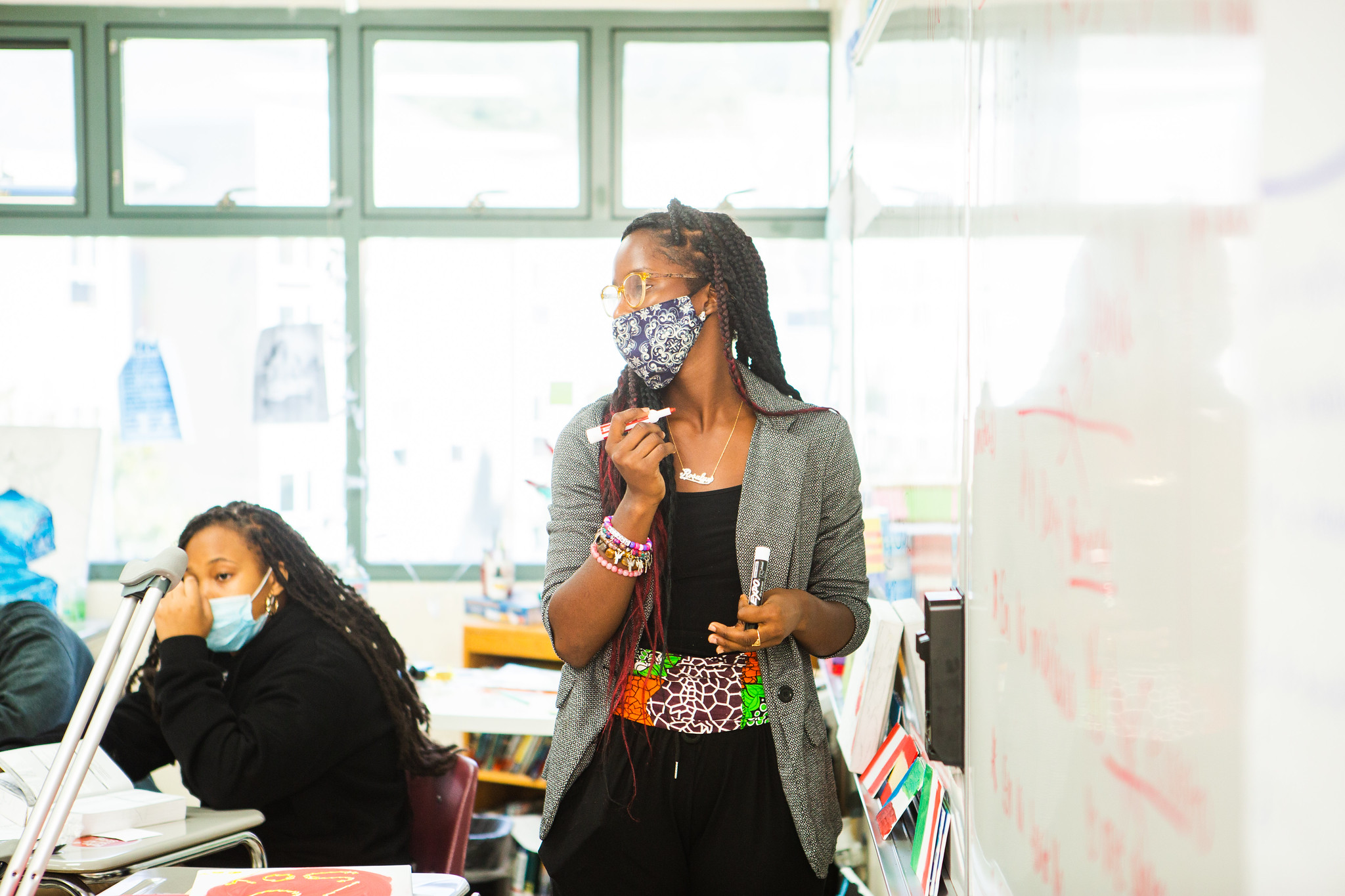
On Wednesday, November 30, 2022, Education Policy Initiative Director Chelsea Coffin testified before the D.C. Council Committee of the Whole, at its public oversight meeting. Her testimony focuses on context on attendance and chronic absenteeism as well as to present the case for more data, published with greater regularity, that can support research on improving attendance. You can read her testimony below, or download a PDF copy.
How much school students attend is a strong indicator of student wellbeing and future academic success, making it a critical metric to track and understand. In D.C., during the virtual school year of 2020-21, even with relaxed attendance requirements,1 31 percent of students were chronically absent, up from 29 percent in 2018-19. Among high school students, 35 percent of students were chronically absent, and among students designated as at-risk, this share was 48 percent. We don’t yet have administrative data for the system to reflect school year 2021-22, but an EmpowerK12 sample of 10,200 public charter school students indicates a chronic absenteeism rate that is ten percentage points higher than pre-pandemic.2

During the virtual school year of 2020-21, attendance was also lower in the noncompulsory grade of pre-kindergarten. Pre-kindergarten students attended school an average of eight out of every 10 days compared to nine out of every 10 pre-pandemic. Pre-kindergarteners who are designated as at-risk attended an average of seven out of every 10 days.

Recorded attendance in school year 2020-21 suggests that students lost significant instruction time during an already challenging virtual school year, and school year 2021-22 does not show early signs of a rebound in attendance. Attendance is a key sign of recovery from the pandemic as it shows the extent to which students are present and able to learn. To address attendance issues, we need better data in real time and research to look into the underlying reasons why students are absent.
To improve data, it would be helpful to both understand the reason for absence and to have more frequent reporting during a school year. Especially during times of heightened COVID-19, flu, and RSV, the system should report whether absences are due to illness or otherwise, which could mean that policies to improve transit, public safety, or general engagement could make a difference in reducing absenteeism. It would also be useful to have a public-facing dashboard at the state level with updates monthly on in-seat attendance, chronic absenteeism (including the share of students who have missed 10 percent or more of the school year, and the share who are severely chronically absent having missed 20 percent or more of the school year), and truancy (including those who have missed more than 10 and more than 15 days of school) during the school year at the system level so that attendance issues are apparent before it is too late to address.
Finally, more research is critical into why students are absent in D.C. and what can be done in our context to improve attendance as well as the implications of absences on learning. This could be undertaken as a part of the DC Education Research Collaborative’s draft research agenda,3 which includes one focus area around success after high school and one around supportive school environments. The Detroit Education Research Partnership, for example, has done a deep dive into this topic, looking into Detroit families’ experiences with COVID-19 and school attendance,4 why students in Detroit miss school,5 and the factors like geography that matter most for attendance for Detroit’s students.6 Before the pandemic, Detroit’s new plan to reduce chronic absenteeism was making a difference, reducing the rate by 8 percentage points. Continued analyses that spotlight the issue over time are happening in parallel to new initiatives for this school year in Detroit. In D.C., the Mid-Atlantic Regional Educational Laboratory (REL) has one study about attendance in DCPS schools, finding a small impact of less than 1 percent on attendance for students who received a home visit.7 It is a great start, but there is more to be done locally to figure out could reduce absences in D.C.
Endnotes
- During school year 2020-21, schools had to change how they collected attendance, with almost all students participating in virtual instruction within a framework and guidance provided by OSSE. To verify virtual attendance, LEAs with a Learning Management System (LMS) required students to be authenticated by that system. Otherwise, some LEAs asked students to make direct contact with a school staff member, some asked them to complete a daily assignment, and some required both. With this flexible definition for attendance in school year 2020-21, the recorded attendance rate was 89.5 percent.
- EmpowerK12. 2022. DC Education Recovery Dashboard. EmpowerK12. Retrieved from https://www.empowerk12.org/dc-recovery-dashboard
- See the draft for public comment: https://urbanorg.app.box.com/s/7i0y11q8d6uyvma5sgnz4tuqh867ww78
- Lenhoff, S. W. and Singer, J. 2021. “Detroit Families’ Experiences with COVID-19 and School Attendance: Survey Evidence from DPSCD.” Detroit Education Research Partnership. Retrieved from https://education.wayne.edu/detroit_ed_research/experiences_with_covid-19_and_attendancerevised.pdf
- Lenhoff, S. W., Singer, J., Stokes, K., & Mahowald, J. B. 2021. Why do Detroit students miss school? Implications for returning to school after COVID-19. Detroit Education Research Partnership, Wayne State University. https://education.wayne.edu/detroit-education-research-partnership
- Singer, J., Lenhoff, S. W., Pogodzinski, B., & Cook, W. 2019. Geography, school type, and high student attendance in Detroit. Retrieved from Wayne State University website: https://education.wayne.edu/detroit-education-research-partnership
- McKie, A., Terziev, J., and Gill, B. 2021. “Impacts of Home Visits on Students in District of Columbia Public Schools.” National Center for Education Evaluation and Regional Assistance at IES, Regional Educational Laboratory Mid-Atlantic at Mathematica (REL 2022-128). Retrieved from https://ies.ed.gov/ncee/edlabs/projects/project.asp?projectID=4597&display=1
